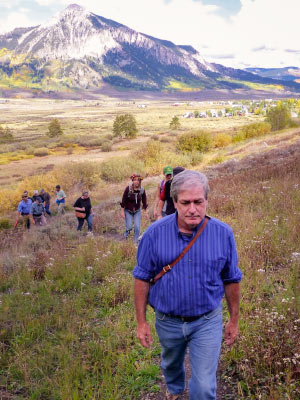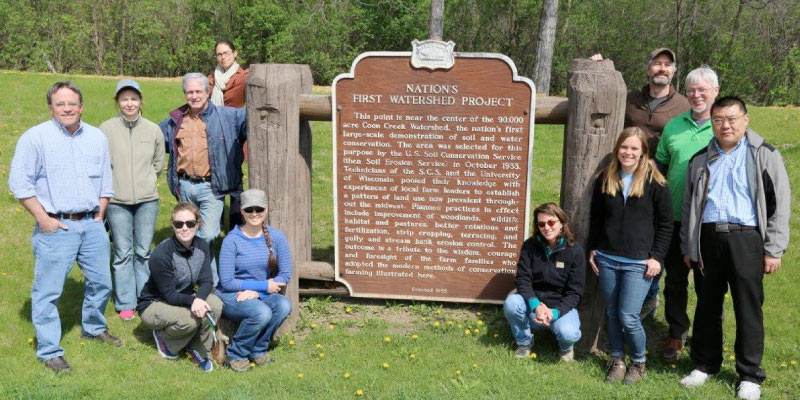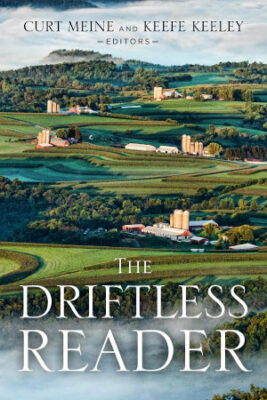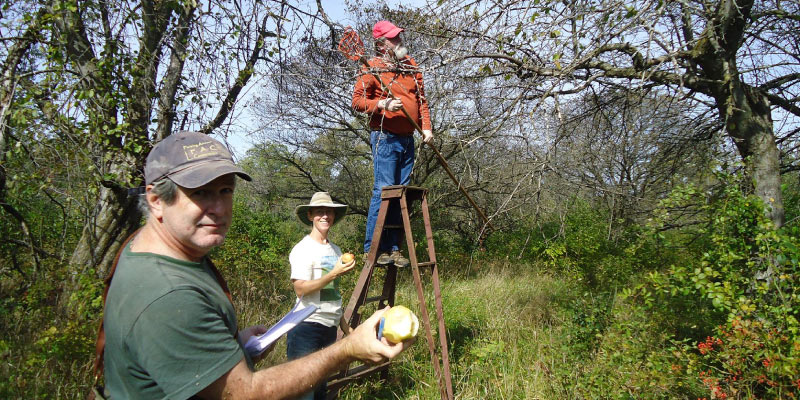
If you get the chance to chat with Curt Meine, the man who’s become more or less synonymous with Aldo Leopold, you may be inclined to pepper him with “What would Leopold think about…” questions. But there’s more to Meine than meets the eye, and there’s more to his life than Leopold.
Sure, Meine wrote the literal book on Leopold’s life — and yes, he was the on-screen narrator of Green Fire, the Emmy-winning documentary on Leopold. He also serves as senior fellow with the Aldo Leopold Foundation, and he’s done more Leopold-related media interviews than he can count. But the next time you encounter Meine enjoying an afternoon on the Memorial Union Terrace, consider asking him about … anything else. Like the community-based conservation efforts at the former Badger Army Ammunition Plant (which he’s helping lead). Or how, after the Cold War, Bulgaria became one of the first countries to pen a national conservation plan (which he helped develop). Or you could scrap all of that, hand him a guitar, and ask him to play one of the tracks on his newly released album of original tunes.
It’s the end of June, and Meine has finally made it to the Terrace. Over nearly 90 minutes, he weaves the threads of his life into audible art, humbly dodging praise and yes, politely answering one “What would Leopold think about…” question. It’s a quintessential Terrace day. Janitorial sparrows clean up popcorn from the pavers. Parents advise their teenage son on colleges to consider. Tunnel Bob ambles by. The first time Meine was here, it was a quintessential winter day. It was January 1981, and it was cold. Very cold. Lake Mendota was covered with a smooth sheet of black ice, dotted with ice fishers and hockey players. “Okay, this is the way you make it through the Wisconsin winters,” Meine said to himself. “You get out there, and you have a good time.”
It was the Nelson Institute for Environmental Studies that brought the young Meine to UW–Madison. He was completing his undergraduate degree in English and history at Chicago’s DePaul University when a UW–Madison brochure in the library caught his eye. “The description of one graduate program captivated me because it was all about interdisciplinary work and about the land,” Meine recalls. “[The program] was called land resources, and that was tangible. It felt very real.”
Meine arrived on campus when the Nelson Institute — then, just the Institute for Environmental Studies — was in its adolescence. Though a fledgling program, its professors and advisors were among the best in the world. “For anyone interested in environmental work, it was one huge academic smorgasbord. Not only could you study anything here, you could study [it] with some of the leading experts in the world.” Meine’s interest in climate change and ethics paired him with the likes of John Kutzbach, Reid Bryson, Francis Bretherton, and Cal DeWitt, to name a few. “These were key leading global figures in climate science, and they were all here.”
The professors coached Meine’s cohort to seek answers by pulling in knowledge from a variety of disciplines. “Our institutions aren’t set up that way. We divide ourselves up into our disciplines and fields and professions,” says Meine. “And yet, there was the Nelson Institute saying, ‘we need to foster this kind of cross-disciplinary, problem-solving way of thinking and connect fields of knowledge.’ That’s how you solve problems.” As Meine considered questions of climate change alongside the burgeoning fields of conservation biology, environmental ethics, and environmental history, his path forward began to take shape; its form a slender, bespectacled man named Aldo Leopold.

On Legacy
Whether you’re a passionate or casual environmentalist, you’ve likely encountered Leopold. High school English classes across the country have incorporated his Sand County Almanac into their curricula to demonstrate creative scientific writing and introduce the idea of land ethics. And if you remember reading it and not especially liking it, you’re in good company. Neither did Meine — at least, not at first. “But of course that’s what durable books do,” he says. “They bear revisiting, maybe when you’re at a different stage in your own development. Where you see things you didn’t see at first, or you’re a little more tolerant of different ways of expression.”
Leopold became Meine’s anchor as he continued his studies. “For almost any field you can imagine in the environmental world,” he points out, “there was some thread that you could track back to Leopold and his contemporaries.” But as Meine got to know Leopold, he learned that —though an oft referenced, well-known figure — there was limited scholarship about his life. “Who was this historic figure, and what can we learn from his life and work?” Meine wondered. He went to the academic smorgasbord, taking courses across disciplines and gathering pieces of his newfound puzzle. “It was a time of great cross-disciplinary ferment, and Leopold was in the middle of it.”

Leopold also became the center of Meine’s academic journey; in 1988, he completed his PhD with his dissertation, Aldo Leopold: His Life and Work. The comprehensive biography was published shortly afterward and has since become an authoritative text on the “father of conservation.”
After spending his graduate school years exploring Leopold’s past, Meine left UW–Madison with renewed clarity for the future. “History can’t give us the answers, but it helps us understand how we got to where we are. Science doesn’t give us all the answers, but it gives us utterly necessary information to help us think through them. And ethics is essential because it helps to guide us through times of uncertainty.” He headed east, where many young hopefuls go to make a difference: Washington, D.C. There he worked for the U.S. National Academy of Sciences in the lead-up to the seminal 1992 Earth Summit in Rio de Janeiro. “That was the most important environmental gathering, arguably, in history,” Meine recalls. From Rio came the annual United Nations COP Conferences and the Framework Convention on Climate Change, which led to the Paris Agreement — and Meine had a front-row seat. “Hell, it wasn’t a front seat. We were on the field!”
Also stemming from the Earth Summit was the Convention on Biological Diversity, a multilateral treaty that called for countries to develop their own biodiversity plans. The first European country to do so was Bulgaria, among the most biologically diverse countries on the continent. Meine found himself on the field again, serving as a technical and editorial advisor to the plan’s development. “My Bulgarian colleagues had the knowledge, the desire, the experience in the landscape, the concern for their own biodiversity legacy. They were the ones who did the work,” Meine emphasizes. “But I got a chance to sit with them and learn from them.” Meine sat in those meetings, tears in his eyes. “In the wake of the Cold War, you could feel the pulse of a new wave of democracy and public participation, putting science to work for the public good. Wow. What could be better than that?”
Perhaps the only thing better could be doing this type of work where Meine’s roots had taken hold: Sauk County, Wisconsin — the land of Leopold, the International Crane Foundation (where Meine is a research associate), and of another Cold War legacy.

On Land
Off Highway 12, just a few miles south of Tewakącąk (or Devil’s Lake State Park), sits a plot of land that once housed the sprawling Badger Army Ammunition Plant — now more commonly known as the Badger Lands. Active from World War II through the Vietnam War, the plant was officially decommissioned in 1997.
That’s when a group of 50 local organizations first gathered to discuss the future of the land. They became the Sauk Prairie Conservation Alliance, with Meine serving as a founding member and coordinator. “We dared to dream, 25 years ago, that this could become a working laboratory in bio-cultural restoration,” Meine says, and it has. His activism and expertise have helped bring the land back to its roots: to plants and animals that once called the landscape home, to the 75 farming families who were vacated to build the plant, to members of the Ho-Chunk Nation who were removed in 1837.
People, says Meine, are at the core of conservation. “How do you bring diverse people together to reconcile difficult histories with the opportunities of the present and the needs of the future?” he asks. And if he knows anything, it’s how to see those threads of time running parallel. “You’re humbled by the history of it, I think,” he reflects. “We are all just here for a short while, building on whatever came before, for ill and good, and doing our best to carry that baton. Carry that and pass it on.”